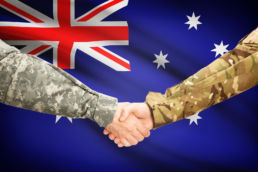LinkedIn Tips for Military-to-Civilian Transition
For many members leaving the Australian Defence Force, LinkedIn is a new technology that they have had little to do with.
Given that over 90% of recruiters now use LinkedIn as a recruitment tool it is important to up-skill on this new tool as quickly as possible.
The following are tips for Australian Defence Members looking to establish themselves on LinkedIn.
- Develop a powerful headline that resonates with your target employers. Ideally this headline should tell them ‘what you are” in civilian terms in 120 characters or less.
- For example:
– Operations Leader specialising in building morale and performance.
– Qualified Training & Development professional. Expert in Change Leadership.
- For example:
- Build a strong summary section that outlines your value offering. Remember this must be written in terminology non-military readers can understand and appreciate. Try to write with their needs in mind, highlighting your relevant skills, qualifications and value.
- You can write this in a straight-forward descriptive summary:
– Operations Leader with more than 20 years’ achievement building team capability and performance. Managed cross-disciplinary teams of up to 60 personnel, consistently delivering well-run and productive teams delivering on objectives. Background working in environments demanding strong skills in resource optimisation and team capability development. Trained in management at the highest standards through military leadership experience and worked with government agencies around the world.
OR - In a personalised first person style (recommended)
– Having led operational teams around the world to deliver on objective under the most challenging of environments I know the importance of vision, integrity and clear communication to building engagement. During my career I have led civilian and military personnel and through this experience its clear to me that at the heart, people are people, and they want to work for something or someone they believe in. My background suits me to organisations looking to build a culture of performance and engagement through genuine leadership and integrity. I am an expert in sourcing strategic partners, leading through change and developing long-term strategic plans.
- You can write this in a straight-forward descriptive summary:
- Keywords are important. When developing your LinkedIn summary, and to populate the skills section, it is important to identify the right keywords. These are the words people will be using to find you.
- Upload a suitable picture. If you want to transition to the civilian sector its important you look civilian so make sure your headshot is professional and business-appropriate.
- Start building your networks. Look for veteran and Defence-related groups and companies that may be helpful for your job search and transition. Use these networks to increase your knowledge, broaden your visibility and open you up to potential opportunities. Most importantly, remember the biggest way to build your networks is to give, so look for ways to help others without expecting to receive back. The payback will often be greater than you imagine.
- Make sure to customise your LinkedIn URL. LinkedIn will assign a URL to you that usually has your name followed by a range of numbers. Simply click edit next to your URL (while you are in edit profile mode) and you can simplify this to something easier.
- Use LinkedIn to support your transition. LinkedIn can be helpful to source job opportunities and to find information during interview preparations. Many organisations are using LinkedIn to source candidates and will advertise vacancies on LinkedIn. Use the LinkedIn job search function to find suitable vacancies. You can also use company listings on LinkedIn to find suitable companies and to gather intel for interview preparations.
Finally remember LinkedIn is like any other networking tool. You need to be active. Simply posting your information and nothing more is like going to a networking event and standing in the corner. Instead use the tool wisely to build genuine connections and relationships with others. The value comes in the using, not the tool.
If you need any assistance with your ADF career transition, contact us for advice.
I wish you bucket-loads of health, happiness and career satisfaction.
Related Posts
Military-to-Civilian Resume Writing | Video
Writing a resume for the first time when leaving the Australian Defence Force can be difficult. This video provides…
Civilian Labour Market Resources for Defence to Civilian Transition
When leaving the Australian Defence Force it's important you undertake effective career...
Applying for Australian Public Sector Roles – Tips for ADF
Applying for Public Sector Roles can be difficult if you have not experienced the recruitment and...
Potential Jobs For Ex-Defence & How to Find Them
Many military personnel worry that there are no jobs for ex-Defence. The good news is this is not the...
Shedding The Military Brand
When leaving the Defence it’s important to understand that your ‘brand’ is more than your history in the Defence force.…
Finding a Good Military Resume Writer
Finding a Military Resume Writer who can translate your Australian Defence Force experience into terminology that the…
Military Resumes – What to write in a civilian resume
When it comes time to leave the Australian Defence Force a lot of Ex-Defence members...
Why We Are a Proud ADF Reserves Supporter
Working every week with Defence members during career change and transition we felt really strongly about adding our…
Swapping Hats – Defence to Civilian Career Transition
Tips for transitioning from a military career to the civilian sector. Useful for ADF members interested...
Job Search for Ex-Defence Personnel – Resources
If you’ve been in the Australian Defence Force for a large portion of your career, the job market...
Selling Your Defence Career in an Interview
Our own Gillian Kelly gives you tips and advice and selling your defence experience and skills when transitioning into…
Translating Your Defence Career To A Civilian Resume
One of the biggest challenges for most Defence personnel is how to translate their military...
Call us, we'd love to hear from you.
Find out how we can design a program to meet your needs.
Not familiar with outplacement? Learn more in our information section – what is outplacement?
Call us, we'd love tohear from you.
Find out how we can design a program to meet your needs.
Not familiar with outplacement? Learn more in our information section – what is outplacement?











